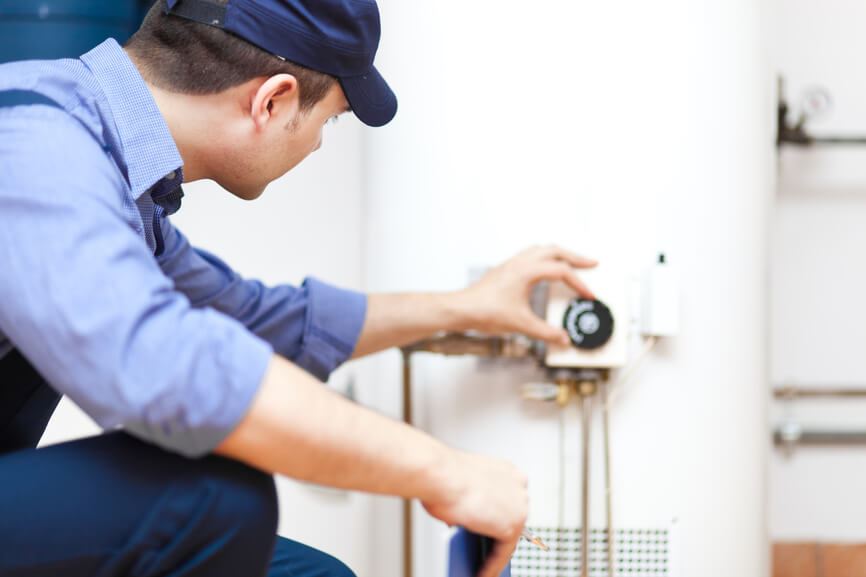Nothing kills your morning groove quite like having to wait ages for that hot shower to finally kick in. Or how about going to wash a load of laundry only to find the water heater is struggling to provide enough hot water? Delayed heating is one of the most annoying water heater issues homeowners face.
The good news is that there are usually some pretty straightforward explanations for why your water heater seems to be dragging its feet lately. Before springing for an expensive service call, it’s worth troubleshooting some common causes and simple DIY fixes yourself first.
Sometimes it’s as easy as adjusting the temperature setting or adding some insulation to those hot water pipes. Other times, the culprit could be a faulty heating element or just excessive buildup of sediment requiring a hands-on flush.
In this guide, we’ll walk through the top reasons why your water heater might be taking forever to heat up. You’ll learn easy troubleshooting steps to try as well as tips on when to wave the white flag and call in the pros. We’ve also included our best preventative maintenance advice to keep your water heater running like a champ.
Whether you’re a homeowner or renter, getting that water heater working properly again is key for hot showers, clean dishes, and avoiding other hot water headaches. Let’s get into the details.

Common Causes for Heating Delays
There are a variety of potential reasons why your water heater might be taking longer than normal to heat up. Some are quick, easy fixes while others may require more involved repair work. Here are some of the most common culprits behind heating delays:
Here are expanded 150 word descriptions of the two common causes, without troubleshooting details:
Thermostat Issues
The thermostat controls when the water heater cycles on to heat up the tank’s water supply. If it becomes defective, stuck, or miscalibrated, it can’t properly regulate this heating process.
On gas units, the thermostat is combined with the gas control valve. Any issues here prevent the burner from firing appropriately.
Electric models have immersed thermostats that can get stuck open (overheating) or stuck closed (no heating). Thermostats can also gradually drift out of temperature calibration over years of use, leading to the tank operating too hot or too cold. A faulty thermostat loses the ability to sense and maintain the intended temperature setting.
Sediment Buildup
Over time, dissolved minerals from the water supply can settle and harden into a crusty sediment layer inside the tank bottom. This builds up into an insulating blanket between the heat source and the water to be heated. The sediment blocks efficient heat transfer, forcing heating components like burners or elements to work harder with diminishing returns.
As the sediment layer increases, it creates longer heating delays as the tank struggles to overcome the insulating barrier. Unchecked buildup strains the system while reducing heating capacity and hastening cooler tank temperatures between heating cycles.
Too Small Tank
As household sizes grow or hot water usage demands increase, an undersized water heater tank can quickly become overwhelmed. Tank capacities are rated to supply a set volume of hot water per hour. If demands like showers, appliances, and faucet use regularly exceed that capacity, the tank can’t recover fast enough between heating cycles.
This causes a depleted hot water supply until the tank fully reheats hours later. Even modest demands like running the dishwasher while someone showers can overtax a water heater that’s too small for the home’s needs. An undersized tank gets drained faster than it can replenish heated water.
Failing Heating Element
The heating elements are the core components that produce the heat energy for the water heater tank. In electric units, the elements are heavy-duty immersed rods or coils.
On gas models, they are the fuel burners and combustion chambers. As these heating elements age and deteriorate, their heating output and efficiency diminishes. The elements can partially burn out, develop mineral/sediment buildup coatings, or corrode over years of use and exposure to tank conditions.
This reduces their heat transfer effectiveness. Eventually heating elements simply wear out and fail completely. Weak or failing elements struggle to fully reheat tanks, resulting in lukewarm temperatures and long heating delays.
Dip Tube Troubles
The dip tube is a critical piece of the water heater’s plumbing system. Its job is to carry the incoming cold water supply down to the bottom of the tank. This allows the cold water to stratify properly underneath the already heated water.
When functioning correctly, the dip tube creates a separation where the heat source can efficiently transfer warmth into the cold layer at the bottom. As that bottom layer heats up, it rises and mixes with the heated water above in a continuous cycle.
However, if the dip tube cracks, breaks, or becomes dislodged from its proper positioning, it disrupts this natural stratification. Cold water gets released closer to the top or mixes immediately with the hot reservoir. This makes it much harder for the heating components to maintain consistent tank temperatures.
Anode Rod Degradation
The anode rod is a key component designed to protect the water heater tank from corrosion and premature failure. It’s a sacrificial metal rod that hangs suspended into the tank’s water supply.
More reactive than the steel tank itself, the anode rod is meant to gradually degrade and corrode over time instead of the tank’s interior lining and walls. This depleting anode material attracts and diverts corrosive molecules away from the tank.
As it deteriorates, the anode rod needs periodic replacement to keep doing its job effectively. If it completely disintegrates down to a thin wire or nub, it can no longer be sacrificed and divert corrosion properly. At that point, the exposed tank surfaces begin rusting rapidly.
Unprotected by a functioning anode rod, the tank will start leaking from accelerated corrosion. Replacing the spent anode rod should extend the tank’s overall service life significantly.
Heat Traps Malfunction
Water heater tanks are equipped with heat traps on the inlet and outlet pipes to improve energy efficiency. These are simple one-way flapper valve mechanisms, usually made of vinyl or plastic.
Their purpose is to allow water flow in and out of the tank when actively delivering hot water. But when the taps are closed, the heat traps seal shut. This traps any residual heat inside the tank rather than letting it escape through the pipes.
Over years of use, these heat trap flappers can break down, get stuck open, or lose their tight sealing ability. When malfunctioning, they remain open constantly, providing an avenue for that heated water and energy to continuously radiate out of the tank.
Without functioning heat traps, the tank has to cycle on more frequently to reheat water that has cooled off too quickly. This increases energy consumption while reducing overall tank capacity between heating cycles.
Faulty Gas Valve (Gas Units)
On gas-fired water heater models, the gas control valve is one of the most important components. It acts as the gateway that regulates the flow of gas fuel to the main burner assembly.
This gas valve contains a cluster of safety mechanisms like thermocouples and temperature limits. If any part gets stuck or obstructed, it can severely limit or cut off gas flow to the burner altogether.
Sediment buildup is a common culprit, gradually clogging the valve’s internal workings over time. The valve can also simply wear out or get knocked out of its proper calibrated settings.
When the gas valve malfunctions, the burner fires unreliably or not at all. This starves the tank of the necessary heat source to fully recuperate between hot water demands.
With any of these common issues, the first signs are usually lukewarm water temperatures or the tank taking much longer than normal to recover and reheat after heavy use. The sooner you troubleshoot and identify the root cause, the quicker you can get that water heater back up to full heating efficiency.
Troubleshooting and DIY Fixes
Now that we’ve covered some of the most common reasons why your water heater may be struggling to heat up, let’s dive into some simple DIY troubleshooting and repair steps you can try before calling in a professional.
Troubleshooting Thermostat Issues
If you suspect thermostat troubles are behind the heating delays, start by checking the temperature setting. On gas heaters, there will be a dial or set of numbers you can adjust. Electric models typically have high/low or numbered settings. Raise the setting initially and see if stronger heating resumes.
If that doesn’t work, you may need to replace the thermostat itself. This relatively inexpensive part ($20-40) controls the entire heating operation. Swapping it out is usually a simple DIY job. Just make sure to shut off power to the heater first!
Troubleshooting Sediment Buildup
To clear out sediment and mineral deposits, you’ll need to flush out the tank. Start by turning off power/gas to the heater, then run a garden hose from the drain valve at the bottom to a floor drain or outside. Open the drain valve fully and allow water to flow until it runs clear and sediment-free.
You can also pour household products like vinegar or sediment removers through the cold water inlet to help further break up deposits. Close the drain valve, remove the hose, and refill before restoring power.
Troubleshooting Too Small Tank
If the root cause is a water heater that’s too small for your demands, your options are more limited DIY-wise. You can try using less hot water by spacing out tasks, taking shorter showers, fixing any leaks, and insulating accessible hot water pipes.
But for a more permanent solution, upgrading to a larger tank (or even going tankless) will deliver better hot water capacity.
Troubleshooting Heating Element
For electric water heaters, checking the heating elements is a very common service task. With power off, you can remove the element(s) and use a multimeter to test for continuity. If faulty, these relatively inexpensive parts can usually be easily swapped out by handy homeowners.
On gas units, the heating tubes or chambers may simply need a thorough manual cleaning to remove debris and mineral buildup.
Troubleshooting Dip Tube
If the cold water doesn’t seem to be entering and stratifying at the bottom, you may have a dip tube problem. First, shut off the heater and drain some water to relieve pressure and make the tank easier to work on.
Then remove the cold water inlet and inspect the dip tube itself for any cracks, breaks or loose connections causing it to leak or let cold water mingle in the wrong spots. You may be able to extract and re-attach it if loose, or opt to replace the full tube.
Troubleshooting Anode Rods
Speaking of removing the cold water inlet, this is also how you’ll access the replaceable anode rod hanging down into the tank. Give it a visual inspection – if it’s ground down to a nub or fully disintegrated, it needs replacing. New anode rods are readily available and can often simply be swapped in with basic hand tools.
Troubleshooting Heat Traps
Heat trap issues should also be evident right at the tank’s inlet and outlet pipes. Look for those little vinyl or plastic flap doors that should move freely to open and close. Try manipulating them manually and replace any that are stuck fully open.
Troubleshooting Gas Valves
For gas units where the burner never fully fires up, cleaning or replacing the gas control valve is worthwhile. First, shut off gas and power, then locate the gas control valve/thermostat housing, usually featuring visible tubes running to the burner.
Following the valve manufacturer’s instructions, you may need to just give it a thorough cleaning and adjusting. Or replacement valves can be ordered to complete a full valve swap.
With some basic tools, a little elbow grease, and extra caution when dealing with gas/fire elements, many of these heating issues can be remedied through diligent DIY. But knowing when to wave the white flag is also crucial.
When to Call a Plumber
Even for avid DIYers, there are some water heater situations where it’s best to bite the bullet and schedule a service call with a professional plumber. Knowing when to wave the white flag can help prevent further damage and bigger headaches down the road.
Failed Leak Tests
If you’ve tried flushing your tank to remove sediment but can’t get the water flowing clear, there may be a crack or risk of impending failure. The same goes if you notice puddles of water around the base of the tank.
At this point, it’s wise to call a plumber to inspect and test for leaks using specialized equipment. They’ll be able to replace the tank safely if a slow leak is springing.
Tricky Access
While many basic service tasks like element swaps or anode rod replacements are DIY-able, sometimes the location and space around the water heater makes things very tight and difficult. Trying to wrestle with an awkwardly installed tank in a cramped closet risks damaging other components or plumbing.
A professional will have the right tools and experience to safely navigate tricky clearances. It’s better to have them handle any complex contortions required.
Gas Line or Exhaust Issues
If your gas water heater’s burner still refuses to fire up properly after you’ve replaced the gas valve and cleaned accessible areas, there could be an issue with the gas supply line or exhaust flue.
These types of intricate gas connections and ventilation setups are best left to certified plumbing experts who can ensure every component is installed correctly and up to current code requirements.
Age/Frequent Repairs
On average, conventional tank water heaters tend to have a service life of around 8-12 years. If your unit is approaching or exceeding that age range and requiring increasingly frequent repairs, it’s likely more cost-effective long-term to simply replace it.
A plumber can help you weigh your options between a more modern tank unit or the space/energy savings of upgrading to a tankless on-demand system. They’ll handle the full disconnect and removal safely.
Electric Hazards
For electric water heaters, make sure to shut off all power sources before attempting any service work that could expose you to wiring, elements or panels with live electricity.
If you ever feel uncomfortable or unsure about working around the electrical components, it’s better to be safe than sorry. Call a plumber to avoid any risks of shocks or shorts that could start fires.
Extensive Rebuilds
In some cases where both the tank and outer jacket are heavily corroded and damaged, it may not be worth attempting to swap out just a few internal components. The more extensive “rebuild” effort can quickly get complicated.
A professional plumber will be able to assess whether you’re better off starting fresh with a full tank replacement rather than chasing multiple part upgrades on an aging, deteriorating unit.
The right plumber will take the time to thoroughly inspect your unit, run diagnostics, and lay out your options – whether it’s a simple repair or time to look at a replacement. Having an expert handle major water heater issues ensures the job is done correctly.
Water Heater Maintenance Tips
An ounce of prevention is worth a pound of cure, especially when it comes to your home’s water heater. Putting in a little maintenance work can go a long way toward maximizing efficiency, minimizing heating delays, and extending the lifespan of your unit. Here are some essential water heater maintenance tips:
Flush the Tank Annually
Over time, sediment and mineral deposits can build up inside the tank, creating an insulating barrier that makes it harder to heat the water effectively. Flushing out this sediment at least once a year is crucial.
Start by shutting off the power/gas and attaching a garden hose to the drain valve near the bottom of the tank. Keep that valve open and allow all the water to empty out until it runs clear of debris. This helps remove built-up gunk.
For a deeper flush, you can pour products like vinegar or specialized flushing compounds through the cold water inlet once fully drained. Let it sit for several hours before restarting the water flow to rinse everything out completely.
Check the Anode Rod
The sacrificial anode rod is a vital component that helps prevent corrosion and rusting of the tank from the inside out. By design, it’s made from materials that will degrade gradually instead of the steel tank itself.
At least once a year, drain off a few gallons from the tank and disconnect the cold water inlet to access and remove the anode rod. Give it a visual inspection – if it’s mostly eaten away and ground down to a nub or wire, it needs to be replaced with a new anode rod.
Insulate Accessible Pipes
You can boost water heater efficiency and prevent energy waste by insulating any exposed hot water pipes leading into and out of the tank. Basic foam pipe insulation is easy to find and can simply be wrapped around bare pipes, then secured with tape or wire.
Go the extra mile and insulate the tank itself if recommended for your model. Special insulating blankets ensure heat isn’t escaping uselessly through the tank walls.
Check Pressure & Temperature Relief Valve
Located on the side of the tank, the temperature and pressure or T&P relief valve is a critical safety component that needs to be regularly tested. If temperature or pressure levels get too high, it allows water to discharge out of the tank.
At least twice a year, gently lift up the valve’s tab to ensure water flows out freely when activated. If not, or if the valve is leaking, it needs to be replaced before pressure builds to unsafe levels.
Look for Leaks
Do a periodic visual inspection around the tank, pipes, valves, and fittings to look for any signs of moisture or water deposits. This could indicate a slow leak that needs to be addressed before leading to bigger problems.
With gas water heaters, use a brush and soapy solution to manually check all gas line connections for any bubbling that would reveal a gas leak.
Consider Replacements
With a typical service life of 8-12 years for tank-based units, efficiency and heating capability will inevitably start to degrade over time. If you’ve owned yours for over a decade and have been experiencing more frequent issues, it may make sense to look into a full tank replacement.
Upgrading to a modern, more well-insulated tank can improve energy efficiency while boosting capacity and heating performance. And you could explore going tankless to really maximize on-demand hot water while saving space.
By taking these simple preventative maintenance steps each year, you’ll keep your water heater working at peak performance levels for as long as possible. This ensures you have reliable supplies of hot water while also maximizing energy efficiency and safety.
Just don’t forget – when heating problems persist or larger repairs are required, it’s wise to loop in a qualified plumbing professional. They’ll be able to diagnose root causes and execute any major fixes correctly the first time.
Hawaii’s Trusted Plumbing Experts for Water Heater Solutions
While many water heater heating issues can potentially be diagnosed and remedied through DIY methods, sometimes professional help is simply the wise solution. Calling in an experienced plumbing technician ensures any complex repairs or replacements are handled safely and by the book.
When heating problems persist despite your troubleshooting efforts, or you encounter gas/electrical hazards beyond your skill level, it’s better to be safe than sorry. A trusted plumbing expert can quickly identify the root causes behind heating delays and offer recommendations – whether it’s a minor fix or time to upgrade to a new unit.
They’ll take the time to thoroughly inspect your system, weigh your options, and execute any involved repairs with the proper tools and expertise. This provides peace of mind that the work is done right the first time while maximizing your water heater’s lifespan.
If you’re experiencing heating delays or any other hot water headaches, don’t hesitate to contact the qualified professionals at Steve’s Plumbing & AC Service. Our team is standing by to get your hot water flowing again quickly and efficiently.
Call (808) 563-4054 today to schedule your water heater service appointment. Steve’s has been the trusted name in plumbing for Hawaii’s residential and commercial customers for over 37 years.











